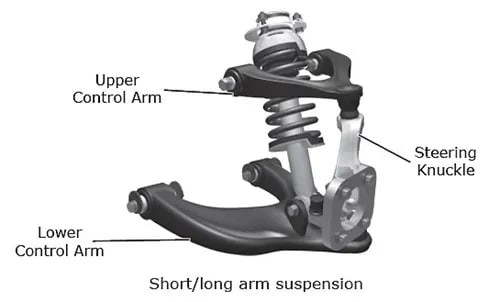The Car Suspension System is a critical component responsible for ensuring a smooth and safe ride. It absorbs shocks from bumps and uneven road surfaces, maintaining tire contact with the road for optimal handling, braking, and acceleration. This comprehensive guide delves into the intricacies of the car suspension system, exploring its function, components, types, and common signs of wear and tear.
How the Car Suspension System Works
The primary function of the car suspension system is to maximize tire contact with the road surface. This ensures optimal friction, enabling effective steering, braking, and acceleration. By absorbing energy from road imperfections, the suspension system isolates the vehicle’s occupants from bumps and vibrations, providing a comfortable ride. Furthermore, it stabilizes the vehicle, minimizing body roll during cornering and preventing excessive bouncing. This intricate system contributes significantly to both driving comfort and vehicle safety.
The principles of road isolation, road holding, and cornering are crucial to understanding the importance of a well-functioning suspension system. Road isolation refers to the system’s ability to absorb impacts from uneven surfaces, preventing them from jarring the vehicle’s occupants. Road holding ensures consistent tire contact with the road, crucial for maintaining control. Cornering describes the system’s ability to keep the vehicle stable and prevent excessive leaning during turns.
Key Components of a Car Suspension System
Several interconnected components work together to form the complete car suspension system:
-
Coil Springs: These resilient components absorb the impact from bumps and dips in the road, compressing and expanding to cushion the vehicle.
-
Shock Absorbers: Working in conjunction with coil springs, shock absorbers dampen the spring’s oscillations, preventing excessive bouncing and maintaining tire contact.
-
Struts: These structural components combine the functions of a shock absorber and coil spring into a single unit, providing support and damping.
-
Control Arms: These linking components connect the vehicle’s frame to the wheel hub assembly, allowing the wheels to move up and down while maintaining alignment.
-
Ball Joints: These pivotal components enable the control arms and wheels to articulate, allowing for steering and suspension movement. They facilitate smooth turning and ensure proper wheel alignment.
Types of Car Suspension Systems
Two primary types of car suspension systems exist:
-
Dependent Suspension: This system utilizes a rigid axle connecting both wheels on an axle. While robust and suitable for heavy loads, it offers limited independent wheel movement. This type is often found in trucks and older vehicles.
-
Independent Suspension: Each wheel is mounted independently, allowing for greater flexibility and improved ride comfort. This design enhances handling and responsiveness, making it prevalent in modern passenger vehicles.
Recognizing Signs of Suspension System Issues
Several indicators suggest potential problems with your car’s suspension system:
-
Pulling to One Side: A vehicle veering to one side while driving may indicate worn or damaged suspension components, such as shock absorbers or control arms.
-
Sagging Corner: A noticeably lower corner of the vehicle suggests a problem with the springs on that side.
-
Excessive Bouncing: Uncontrolled bouncing after hitting a bump indicates worn shock absorbers or struts.
-
Unusual Noises: Clunking or knocking sounds, particularly when traversing bumps, often point to worn ball joints, control arm bushings, or other suspension components.
-
Vibrations: Vibrations felt through the steering wheel or floorboard can be a symptom of worn suspension components.
-
Uneven Tire Wear: Premature or uneven tire wear patterns can indicate misalignment or suspension issues.
Conclusion
The car suspension system plays a vital role in ensuring a safe and comfortable driving experience. Understanding its function, components, and common problems enables informed maintenance decisions and contributes to overall vehicle safety. Regular inspections and timely repairs are essential for maintaining a well-functioning suspension system, promoting optimal vehicle performance and longevity. If you experience any of the signs mentioned above, it’s crucial to consult a qualified mechanic for diagnosis and repair.


